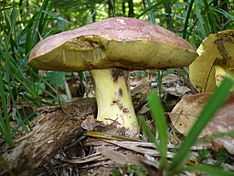Boletus regius
| Boletus regius | |
|---|---|
 | |
| B. regius in Austria | |
| Scientific classification | |
| Kingdom: | Fungi |
| Division: | Basidiomycota |
| Class: | Agaricomycetes |
| Order: | Boletales |
| Family: | Boletaceae |
| Genus: | Boletus |
| Species: | B. regius |
| Binomial name | |
| Boletus regius Krombh. (1832) | |
| Synonyms | |
|
Boletus appendiculatus var. regius Konr. | |
Boletus regius, commonly known as the royal bolete or red-capped butter bolete, is a basidiomycete fungus of the genus Boletus found in China, Europe, and North America. B. regius has a pink cap, yellow flesh, and a reticulate pattern on the stem.[1] Harry D. Thiers described a similar mushroom from California as B. regius,[2] although it has yet to be shown to be the same species. B. regius in Europe does not stain when exposed to air,[1] or stains weakly,[3] but the California species stains blue.[4] Both European and California specimens are considered choice edibles.[5]
Taxonomy
The species was first described and illustrated by Julius Vincenz von Krombholz in 1832.[6] Common names for the mushroom include the red-capped butter bolete[4] and the royal bolete.[7]
In the genus Boletus, B. auripes is classified as a member of the section Appendiculati. Species in this section are characterized by having a dry cap with a surface texture ranging from smooth to somewhat tomentose, yellow flesh, a reticulate stem, and a mild taste. Other North American boletes of Appendiculati include Boletus speciosus and Boletus auripes.[8]
Description

The fruit bodies of Boletus regius have caps that are initially convex before flattening out in maturity, reaching a diameter of 7–20 cm (2.8–7.9 in) wide. The cap surface is pink to red, occasionally with hints of yellow or brown, more so around the margin. Initially velvety to slightly tomentose (hairy) when young, these minute hairs tend to slough off with age, and the cap develops wrinkles and pits. The cap flesh is yellow, and slowly and erratically bruises blue in North American specimens. The pores on the underside of the cap are angular, and measure about 1–2 per millimetre. The color of the pore surface is bright yellow to start, but eventually darkens somewhat, and will stain blue with damage. The depth of the tubes comprising the pores extends to 0.8–2.5 cm (0.3–1.0 in).[4]
The stem measures 5–13 cm (2.0–5.1 in) long by 2.5–5 cm (1.0–2.0 in) thick, and typically has a thick, bulbous base. It is solid (i.e., not hollow), and a bright yellow color, often with reddish tones, particularly near the base of the stem. The stem surface can be covered with fine yellow reticulations either throughout its length, or just on the upper portion. Boletus regius produces an olive-brown spore print. Its smooth, hyaline (translucent) spores are roughly elliptical to somewhat fusoid (wider in the middle and tapering toward the ends) to more or less cylindrical, and have dimensions of 12–17 by 4–5 μm.[4]
Chemical tests can be used to help identify Boletus regius in the field. The cap cuticle will stain a pale purple color if FeSO4 is applied; this same test will turn the flesh grayish.[4]
Habitat and distribution
Boletus regius is an ectomycorrhizal species with a broad host range,[9] and associates with oak and conifers, particularly fir. Fruit bodies grow singly, scattered about, or grouped together. In North America, they usually appear from August to November, although they also appear between May and June. The North American distribution includes the Pacific Northwest states of California, Oregon, and Washington, where its frequency of occurrence ranges from "rare to locally abundant".[4] It is rare in Europe, and appears on the Regional Red List of several countries.[10] The species has also been recorded from China.[11]
See also
References
- ↑ 1.0 1.1 Assyov, Boris. "Boletus regius Krombh.". Boletales.com. Retrieved 2011-04-06.
- ↑ Thiers, Harry D. (1975). California Mushrooms: A Field Guide to the Boletes. New York, New York: Hafner Press.
- ↑ Ellis JP. (1990). Fungi without Gills (Hymenomycetes and Gasteromycetes): An Identification Handbook. Springer. p. 46. ISBN 978-0-412-36970-4.
- ↑ 4.0 4.1 4.2 4.3 4.4 4.5 Bessette AE, Roody WC, Bessette AR. (2000). North American Boletes. Syracuse, New York: Syracuse University Press. p. 147. ISBN 978-0-8156-0588-1.
- ↑ Wood, Michael; Stevens, Fred. "Boletus regius". California Fungi. Retrieved 2011-04-06.
- ↑ von Krombholz JV. (1832). Naturgetreue Abblidungen und Beschreibungen der essbaren, schädlichen und verdächtigen Schwämme [Realistic Illustrations and Descriptions of Edible, Harmful, and Suspicious Fungi] (in German) 2. Prague: In Commission in der J. G. Calve'schen Buchhandlung, 1831–1846. p. 3, t. 7.
- ↑ "List of recommended English Names for Fungi in the UK" (PDF). British Mycological Society. 2003.
- ↑ Snell W, Dick EA. (1970). The Boleti of Northeastern North America. Lehre, Germany: J. Cramer. pp. 74–5. ISBN 978-0854860166.
- ↑ Smith SE, Read DJ. (2008). Mycorrhizal Symbiosis. Academic Press. p. 198. ISBN 978-0-12-370526-6.
- ↑ Koune J-P. (2001). Threatened Mushrooms in Europe. Council of Europe. p. 29. ISBN 978-92-871-4666-3.
- ↑ Chiu WF. (1948). "The boletes of Yunnan". Mycologia 40 (2): 199–231 (see p. 224). JSTOR 3755085.
External links
| Wikimedia Commons has media related to Boletus regius. |